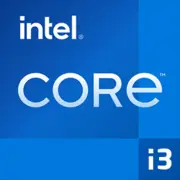Intel Core i3-6320

Intel Core i3-6320: Overview and Practical Tips for Building a PC in 2025
(Relevant as of April 2025)
Key Specifications: SkyLake in Detail
The Intel Core i3-6320 processor, released in 2015, remains a niche solution for budget systems due to its energy efficiency and stable performance. Let's examine its key parameters:
- Architecture: SkyLake (6th generation Intel Core).
- Manufacturing process: 14 nm — a step forward for its time, but by 2025, the standard has become 7 nm or less.
- Cores and threads: 2 cores / 4 threads (Hyper-Threading).
- Frequency: Base — 3.9 GHz (without Turbo Boost, as the i3 line does not support it).
- Cache: L3 — 4 MB.
- Graphics: Intel HD Graphics 530 (base frequency 350 MHz, maximum — 1150 MHz).
- TDP: 51 W — low power consumption.
- Performance: Geekbench 6 — 1298 (Single-Core), 2618 (Multi-Core).
Key Features:
- DDR4 support — relevant for budget builds even in 2025.
- Integrated HD 530 graphics — suitable for office applications and 4K video playback.
- Intel Quick Sync Video technology — accelerates video encoding/decoding.
Compatible Motherboards: What to Choose?
This processor uses the LGA 1151 socket (revision v1), which limits the choice of motherboards to older models. Main chipsets:
- H110: Budget option (price: $60–80). No USB 3.1 Gen2 support, maximum 2 RAM slots.
- B150 / H170: Optimal choice ($70–100). More SATA/USB ports, RAID support.
- Z170: Premium segment ($100–130). Allows RAM overclocking, but the i3-6320 itself is not unlocked.
Tip: In 2025, new boards for LGA 1151 are rarely produced. Look for leftovers on platforms like Amazon or specialized stores. For example, the ASUS B150M-A is a reliable option for $85.
Supported Memory: DDR4 as a Standard
The i3-6320 works with DDR4-2133 in dual-channel mode. The maximum capacity is up to 64 GB (depending on the motherboard).
Features:
- DDR5 and DDR3 are not supported.
- 8 GB (2×4 GB) is sufficient for office tasks.
- For multimedia tasks (e.g., video editing in 1080p) — 16 GB (2×8 GB).
Example: A Crucial DDR4-2133 16 GB kit (2×8 GB) costs about $45.
Power Supply: How Many Watts Do You Need?
With a TDP of 51 W, the processor is not demanding on the PSU, but it's important to consider other components:
- Integrated graphics: A PSU of 300–350 W is sufficient (e.g., EVGA 350W for $40).
- Discrete graphics card: If adding an NVIDIA GTX 1650 (TDP 75 W), choose a PSU of 450–500 W (Corsair CX450 — $55).
Important: Don’t skimp on the PSU. Cheap models can operate unstably even with low TDP.
Pros and Cons of the i3-6320 in 2025
Pros:
- Low power consumption — ideal for compact PCs and HTPCs.
- Good single-core performance — quick response in everyday tasks.
- Hyper-Threading support — better multitasking than Pentium.
Cons:
- Only 2 cores — weak multi-threaded performance (not suitable for rendering or modern gaming).
- Outdated socket — upgrading to newer processors is not possible without replacing the motherboard.
- No support for PCIe 4.0/5.0 — a limitation for modern SSDs and graphics cards.
Use Cases: Where is the Processor Relevant?
1. Office tasks: Document work, browsing (10+ tabs), Zoom conferences.
2. Multimedia: Watching 4K video (via HDMI 1.4), streaming services.
3. Light gaming: CS:GO, Dota 2 on low settings (HD 530 delivers ~30–40 FPS at 720p).
4. Home server: Its energy efficiency makes it a good candidate for NAS.
Real Experience: A user built an HTPC with i3-6320 + 8 GB RAM + 256 GB SSD. The system handles 4K HDR through Kodi, but it occasionally lags when running a browser and streaming simultaneously.
Comparison with Competitors
- AMD Ryzen 3 1200 (4 cores / 4 threads, price $60–80 used): Better in multi-threaded tasks, but requires a discrete graphics card.
- Intel Pentium Gold G6400 (2 cores / 4 threads, $80 new): More modern (2020), but similar performance.
- Raspberry Pi 5 (ARM, $80): An alternative for enthusiasts, but x86 compatibility is important for Windows.
Conclusion: The i3-6320 falls short against Ryzen in multi-threading but wins thanks to its integrated graphics.
Practical Assembly Tips
1. SSD is a must: Kingston A400 480 GB ($35) will speed up system boot times.
2. Cooling: The stock cooler is sufficient, but for quiet operation, consider the Deepcool GAMMAXX 400 ($25).
3. Case: Mini-ITX saves space (Fractal Design Node 202 — $90).
4. Upgrade: Don’t plan for upgrades — the platform is outdated. Build it as a temporary solution.
Example Build:
- Motherboard: ASUS H110M-K — $70.
- Memory: 16 GB DDR4 — $45.
- Storage: 500 GB SSD — $40.
- PSU: EVGA 450W — $50.
- Total: ~$300 without the case.
Final Conclusion: Who is the i3-6320 Suitable For?
This processor should only be considered in two cases:
1. Budget build for an office or media center, where energy efficiency and quiet operation are essential.
2. Upgrade of an old PC while retaining the motherboard (e.g., replacing a Pentium with an i3).
Price: In 2025, a new i3-6320 can be found for $80–100, but it is often sold used for $30–50.
Alternative: If the budget allows, it’s better to go for a Ryzen 5 5500 (6 cores / 12 threads, $120) or an Intel Core i3-12100 (4 cores, $140).
The Intel Core i3-6320 may be a relic of the past, but even in 2025, it can find its place where simplicity and minimalism matter. However, for modern tasks, it's wise to consider newer platforms.
Basic
CPU Specifications
Memory Specifications
GPU Specifications
Miscellaneous
Benchmarks
Compared to Other CPU
Share in social media
Or Link To Us
<a href="https://cputronic.com/index.php/cpu/intel-core-i3-6320" target="_blank">Intel Core i3-6320</a>